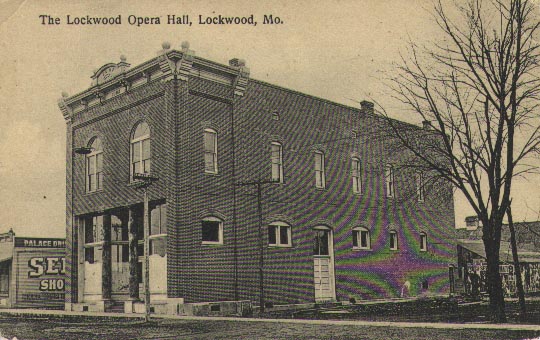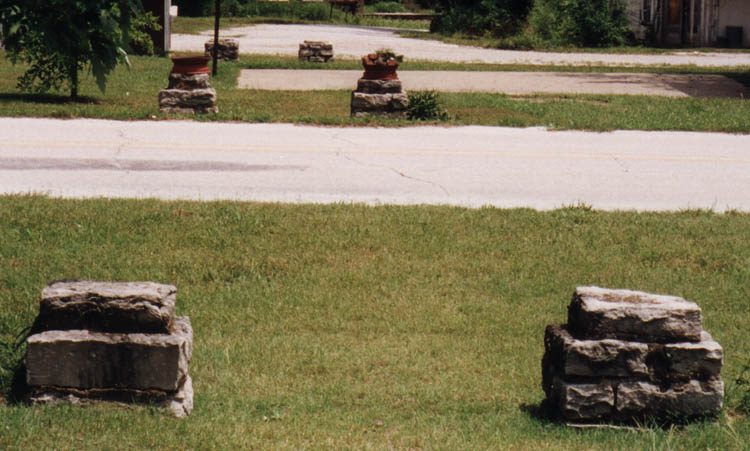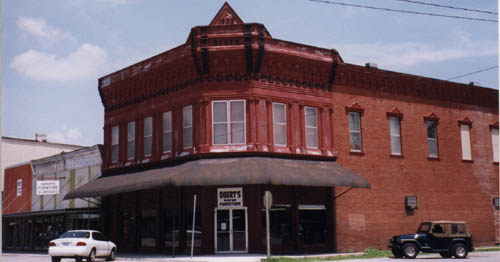|
|
|
 |
Dade County Communities |  |
|
Lockwood, South Greenfield, and Corry All the information is copied from the book, "History of Dade County and It's People." The copyright laws release the copyright after 75 years. The book was published November 1, 1917. I in no way intent to take credit for other people's work. This page is a time portal for all interested parties. |
||
| Lockwood, Missouri
"The Queen City of the Prairie" claims the distinction of being the commercial metropolis of Dade County. Delightfully situated in the heart of a fertile prairie with a broad reach of territory lying both to its north and south without railroad facilities, gives Lockwood a decided advantage as a shipping point. It is indeed one o the best shipping points on the entire Frisco system. |
||
 Information on the back of this postcard reads, "Pub. th the Misses Drolesbaugh, Lockwood, Mo - Printed in Germany. Lockwood was settled by a predominately German population. This buildiing is still standing and was used for a movie theatre in the early 1980's. The top of the building has the I.O.O.F. listed. |
||
| South Greenfield, Missouri
Prior to the year 1881 there were no railroads in Dade County. In that early day Greenfield was the metropolis of the county and all the horsetracks in the road pointed in that direction. The old railroad survey to which Dade County had subscribed bonds in the sum of ,000.00 touched the townsite of Greenfield on the southwest but when the Kansas City, Fort Scott and Gulf Railroad was built in 1881 it missed the town three miles. It followed a natural depression out of the Turnback and Limestone hills to the prairie leaving the county seat stranded on high and dry ground. People in their enthusiasm and speculation expected to see Greenfield with her business interests and county offices move bodily to the railroad point. To facilitate this enterprise Levin W. Shafer, in company with John A. Ready, two Greenfield lawyers and real estate dealers having financial relations with the Dade County Bank, purchased a 41 acre tract of land and laid out the pretentious city of sough Greenfield, with its spacious Public Square upon which a Court House was to be erected when the county seat was removed to that point. John A. Myers immediately platted an Addition on the northwest, G. W. Yeager an Addition on the southwest, Jacob Cox sold lots by metes and bounds on the south and L. J. Griggs Addition on the north, but this plat was never recorded. Many business men from Greenfield became interested in South Greenfield enterprises. Horace Howard embarked in the livery business, J. L. Wetzel sold general merchandise and many other lines were represented so that in a few years the new city attained a population of about 600. At this juncture the unexpected happened. T. A. Miller, a man of action and great business sagacity conceived the idea of building a branch railroad from Greenfield to South Greenfield by popular subscription. Greenfield business men took kindly to the idea and in a short time the Greenfield & Northern railroad was a reality. Its original promoters expected to extend this line to Stockton and on the some Missouri River point, but the north corporate limits of Greenfield became and remained its northern terminus. The rolling stock of this road consisted of one little wheezy, jerky engine, one box car and one combination express-baggage-passenger coach, one hand-car with tools and equipment sufficient for the section foreman and one hand. Later on this road was extended southward thirty miles to Aurora and was sold to the Frisco system and is now one of its important branches. With the building of this railroad the county seat hopes of south Greenfield gradually faded and finally vanished in thin air. The boom proclivities of the town subsided and its population gradually diminished until now it has something like 300 people within its corporate limits. Having Lockwood on the West, Everton on the east, Greenfield on the north and Pennsboro on the south its trade territory is restricted and yet, notwithstanding all this South Greenfield has made a substantial little city, junction railroad point and is the center of a rock-road district with about 20 mile of permanently improved highways. It has privately owned electric light and water-works systems, a beautiful public park, is the home of the Cumberland Presbyterian Camp Grounds and is in every way a very desirable place in which to live. The prominent business men of South Greenfield at present are: J. H. Fuqua, dealer in hardware, furniture, agricultural implements, automobiles, undertaking and fertilizers, in one of the best known business men in Dade county. He has resided in South Greenfield practically all his life, his father having been engaged in the livery business there over 25 years ago. Willard Daughtery, another native son, engaged in the grocery business with a large and ever increasing trade. J. L. Gilliland, groceries, flour and feed, is one of the permanent fixtures of the town. He has been in business many years and enjoys the supreme confidence of his patrons. L. S. Couplin, drugs and medicines. Dr. Couplin is also a regular practicing physician and is one of the valuable men of the community. The T. A. Miller Lumber Company, is one of the oldest established firms of the city, this being one f a line of lumber yards extending over a part of Missouri and Arkansas. It has been in business at South Greenfield since the starting of the town. The Farmers' State Bank is one of the sound financial institutions of the country and ably managed by W. L. Ferguson, cashier. It is comfortable housed in its own brick building on the west side of the square and is equipped with all the up-to-date appliances for modern banking. South Greenfield has always been an extensive shipping point for poultry, produce and grain. The original Frisco depot which was destroyed by fire some two years ago has been replaced with a commodious station house with convenient offices, freight room and passenger waiting room. South Greenfield has suffered two commercial misfortunes. A number of years ago an extensive lime and building-stone works were established on its western suburb which employed a large number of laborers and annually shipped many car loads of lime and building stone. The quarries are among the best in the state. The buildings were destroyed by fire and were never re-built. About the same time the large 200 barrel flouring mill was also destroyed by fire and has not since been re-established. South Greenfield has long been known as a religious and Fraternal center. For more than fifty years a camp ground for religious services has been maintained in a beautiful grove adjoining the city on the northwest. It is shaded with native forest trees of oak, a bright, sparkling, bubbling spring furnishes a never failing supply of pure water and a suitable church building, tabernacle, restaurant and other conveniences have been erected. The grounds are lighted with a modern ascetylene plant and thousands of people visit this place annually. It is now the property of the Cumberland Presbyterians. The Odd Fellows some years ago erected a large, two-story frame business house with lodge rooms above, and for many years South Greenfield has had one of the most prosperous Odd Fellow and Rebekah lodges in the country. South Greenfield is incorporated as a village by the County Court under the laws of the state of Missouri and is governed by a Board of five trustees, viz: W. L. Miller, Chairman W. L. Ferguson, Treasurer. F. J. McMillen, Clerk and Collector. J. H. Fuqua. J. L. Gilliland. J. N. Godfrey. H.O. Woy, City Attorney From the book, History of Dade County and It's People, The Pioneer Historical Company, November 1, 1917, pp. 217-221, 238-240. |
||
 South Greenfield Mystery While taking photos of the post office and bandstand I noticed these stone mounds. Obviously they served some purpose at one time. What was that purpose? Now, I have a mission for my next visit to Dade County. I have to find out what those were used for. If you know, please email me with the answer! |
||
| Corry, Missouri
A cloud of uncertainty rests over the first discovery of mineral at Corry. Tradition says that prior to the coming of the pioneer, the dusky red man dug lead from those native hills and smelted it in the crude furnaces along the banks of Sac River, but that is only tradition. Shallow mineral, mostly silicate, was known to exist in the vicinity of the Pemberton Mill many years ago, but its value to the pioneer was unknown. About the year 1874 the mining industry in Dade county took a boom, and its activity spread over a large scope of territory, but finally settled in a camp at Corry. The diggings were for lead at first, but later on the silicate was also mined. Very little machinery was used. A pick, shovel, wheelbarrow, windlass and rope was considered a complete mining outfit. Wash places were erected along the spring branch east of the town and smelters were built for reduction of the lead ores. On the 27th day of March, 1875 J. M. Blakemore, J. M. Alexander and Sylvinia Alexander, his wife, owners of the land upon which Corry is located, caused a plat to be made and the land surveyed into streets, alleys and town lots. No name as yet had been selected for the new village. Tradition again says that the Alexanders had a daughter by the name of Cora, and suggested to the surveyor who made the plat that the town be called Cora. Either by reason of illiteracy or dullness of hearing the name "Corry," was attached to the plat and so remains to this day. At this time from 500 to 1,000 people were camped at or in the vicinity of the mining camp. The stables, restaurants and other business enterprises belonging to a booming mining camp. On the 20th day of April, 1876, eighty-five citizens of the place presented to the County Court of Dade County a petition praying to be incorporated under the laws of the state of Missouri as a village. The petition was granted and W. M. Taggart, Z. Norris, A. H. Snyder, W. K. Pyle, J. C. Babb and J. M. Stookey were appointed the first Board of Trustees. Most of the petitioners as well as the trustees are either dead or removed from the county. W.M. Taggart afterward located at Lockwood in the real estate and banking business, J. M. Stookey was at the time Judge of the Probate Court and W. K. Pyle afterward filled the same office. The Corry boom was short lived. In a few years the price of mineral declined, transportation to the railroad was difficult and expensive, the deep shafts proved a failure, and finally when silicate was quoted at per ton f. o. b. the bubble collapsed. Levin W. Shafer had been the moving spirit of the town and through his efforts foreign capital was interested. DeArmond, Shoemaker an others were associated with him in these ventures. F. D. W. Arnold, owner of the Pickwick Hotel at Lamar, was a prosperous liveryman of the boom days, while "Dad" Sullivan, "Dutch" Kimber, J. A. Thurman, Alex Foster and other residents of Greenfield each survived a severe attack of Corry fever. Corry is now little more than a wide place in the road. A store or two, a blacksmith shop, a Holiness church, a dozen or more isolated dwellings, a few shallow diggings and a day-dream of former greatness is all that remains to mark the place of Dade Counties "Deserted Village." |
||
 Obert's Furniture in beautiful downtown Lockwood. Lockwood, unlike most Dade County communities, has all the businesses full. There were no vacant buildings on Main Street when I was there in the summer of 2002. Pretty impressive! |
||